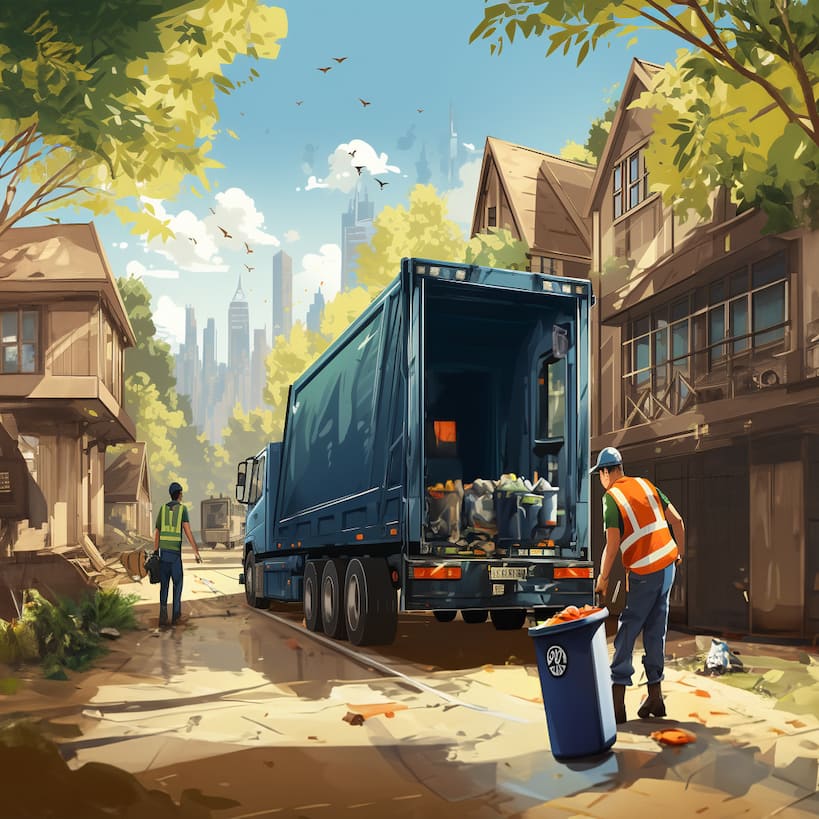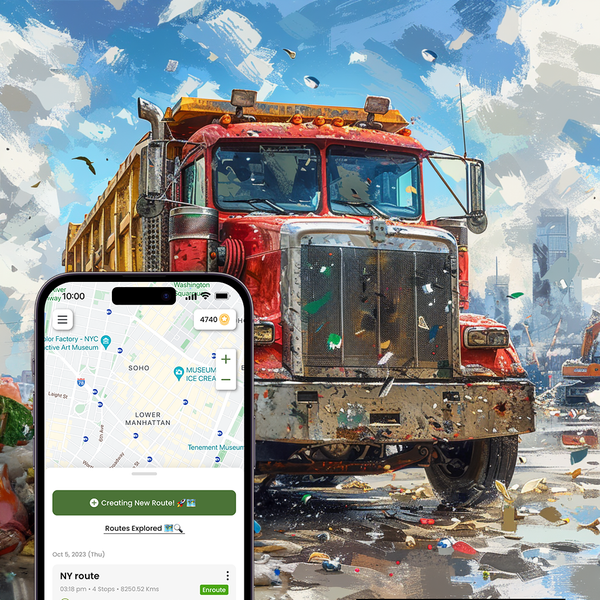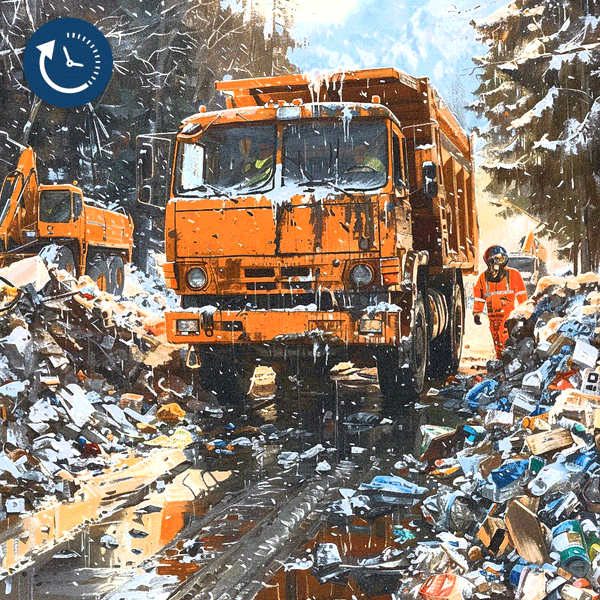Did you know that the annual global solid waste amounts to a whopping $2.01 billion? At least one-third of it is managed in an environmentally unsafe manner.
Wondering why? A prominent reason is the continued dependence on conventional waste management methods that are neither cost-effective nor eco-friendly.
Therefore, it is high time waste management companies switched to sustainable and tech-enabled waste management methods. Route optimization software is one such smart solution that is beneficial in the field of waste collection and disposal.
This software helps create highly efficient and optimized routes that drivers can follow to collect waste. It not only decreases time & fuel consumption but also facilitates greener solid waste collection operations.
This blog elucidates how route optimization software can be a game-changer for waste management companies. But first, let’s understand the challenges of traditional waste collection and disposal methodologies.
Challenges of Traditional Waste Management Processes
Traditional waste collection and management approaches were the norm until a few years ago. However, with global waste projected to touch $3.4 billion tonnes by 2050, an overhaul in the waste management strategy is imperative.
The reason is the significant limitations of age-old waste collection methods that render them unviable.
Here are a few.
- Poor visibility into dynamic demands and waste generation patterns limit adaptability and agility in manual route planning.
- Rigid schedules and routes increase the chances of inefficient resource utilization and idle time at times.
- The inability to plan the most efficient routes causes higher fuel consumption and wear and tear, escalating operational costs.
- The absence of centralized visibility into multiple drivers’ routes renders waste management companies unable to track real-time progress.
These shortcomings of conventional solid waste collection and disposal operations have consequences, as follows.
- Exposure to land and water-borne pollution leads to severe health hazards.
- Poor solid waste treatment methods like incineration increase carbon emissions and global warming.
- Substandard waste management processes like landfills or ocean dumping are detrimental to floral and faunal diversity.
- Open dump sites, often on a city’s outskirts, give rise to social and environmental injustice for marginalized communities residing there.
- Ineffective solid waste collection facilities spoil a city’s aesthetic appearance, dissuading tourists and private investments and causing economic stagnation.
However, implementing advanced route planning software can help overcome the above-mentioned challenges and enhance the solid waste collection process.
Benefits of Route Optimization Software for Waste Management Companies
Picture this. You are a waste management supervisor responsible for waste collection and disposal operations in a city. With a fleet of 40 collection vehicles to serve different areas, you are supposed to create the most optimal routes for each.
What would be your route optimization approach here?
Opting for manual route planning while considering factors such as traffic congestion, distance, availability, or vehicle type may take you ‘forever.’ Even if you succeed, the chances of human errors are high and can render these waste collection routes inefficient, time-consuming, and fuel-intensive.
It is where implementing route optimization software can save the day for you. It is an advanced software that leverages advanced algorithms and analytics to map out the best routes for drivers. This waste management software, thus, helps maximize resource utilization and cut down on operating costs.
Route optimization software paves the way for waste management companies to streamline waste collection field operations and boost overall efficiency.
Let’s explore the several benefits it provides to understand how.
Decreased operational costs
Using route optimization software, a waste management company can consider variables like maximum allowable speed and traffic conditions. It can also factor in vehicle type, speed, or driving preferences, including avoiding tolls/highways, to optimize collection routes accordingly.
This software, thus, ensures drivers traverse the minimum distance to cover the maximum collection addresses. It also helps decrease the wear and tear of a solid waste collection vehicle to save money on its upkeep services. Optimizing routes this way enables a company to streamline fleet management, cut fuel costs, serve more customers, and reduce operational costs.
Minimized waste collection time
A waste management company aims for efficient route planning to reduce waste collection time and increase productivity. Route optimization software helps evaluate drivers’ daily schedules and break intervals while assigning them waste collection points accordingly.
This software allows for factoring in such as vehicle type, speed, and driving preferences, including avoiding tolls/highways. Evaluating all these criteria cumulatively helps determine the shortest and least time-consuming waste collection route. These optimized routes help cut down on the time spent on driving and expedite collection operations.
Higher customer satisfaction
Consistent and reliable schedules, along with notifications, are crucial to maintaining transparency in the solid waste collection market today. Besides, customers may sometimes prefer trash collection in specific service windows. It is where route planning software can play a vital role.
It enables planning routes according to the customer’s availability to minimize missed collections. Route optimization software also helps configure custom dispatch notes and real-time notifications that provide dynamic ETAs and real-time tracking. All these functionalities cumulatively lead to elevated transparency and satisfaction levels.
Better control over drivers’ routes
Tracking on-field solid waste collection vehicles is essential to ensure the drivers follow the assigned routes properly. Route optimization software not only helps plan routes for drivers but also monitors any deviation from them in real-time. It also facilitates adjustments to the preassigned optimal route to respond to the demand change.
For instance, you can add stops to a route plan and mark them as high-priority. You can also assign additional drivers to a route plan if needed to ensure on-time collection. This software also lets you track the actual path taken against the scheduled route to identify and minimize deviations, ensuring the service goes as planned.
Greater power to drivers
As drivers are pivotal to a solid waste management company, enabling them to have certain control over waste collection routes is valuable. Route optimization software helps reduce their dependence on the supervisor’s guidance and respond quickly to dynamic traffic situations and demands. Using it, a waste management company can enable drivers to edit or update a collection route, stop, or priority order.
For example, let’s say a driver finds that a building has collapsed, blocking the assigned path to reach a collection stop. Using route optimization, they can take an alternative route and change the order of collection points accordingly. They can further inform the dispatch manager to boost transparency while enhancing responsiveness to changes. It empowers them to perform optimally and maximize collection.
Reinforced regulatory compliance and safety
Adhering to traffic regulations is pivotal to preventing any violations or suits. Route optimization software helps consider legal maximum speed, one-way streets, or noise ordinances while planning the best route for waste collection. Besides, it also helps keep drivers from entering no-go or hazardous zones, minimizing accidents or injuries.
For instance, handling medical or industrial waste necessitates implementing strict regulatory policies. Route optimization software helps comply with transportation paths and dump sites that local authorities designate while creating optimized routes.
It further tracks the time spent at each collection site to prevent a driver’s prolonged exposure to toxicity or radioactivity. So, route mapping software is key to achieving regulatory adherence and safety.
In-depth performance evaluation
Manual planning fails to deliver performance insights, rendering businesses unable to identify areas of improvement in their waste management operations. Route optimization software provides detailed route plan reports. You can leverage these insights to view the total waste collections scheduled for a day, week, month, or a particular duration.
You can also track the stops that drivers missed or are yet to visit along multiple routes. It helps find the total percentage of successful, missed, and overdue waste collections in a specific period. Besides, you can drill down into an individual driver’s performance metrics, including utilization, average service time, or idle/overtime hours. All these functionalities help evaluate the performance of the fleet or an individual and take necessary improvement measures.
Lowered environmental impact
Fortune Business Insights’ report reveals:
The global green technology and sustainability market size is expected to touch $61.92 bn by 2030.
This figure is a testimony to the rising awareness and adoption of environment-friendly services. The solid waste management industry is no exception as it looks to reduce carbon emissions and the greenhouse gas effect its operations generate.
Route optimization software helps create optimal routes based on vehicle capacity, traffic congestion, drivers’ schedules, and other constraints. It reduces the trucks required to operate on a collection route or disposal sites and hence, the carbon footprint. This way, it contributes to greener or eco-friendly collection services.
Frequently Asked Questions
What is route optimization?
Route optimization is the process of creating a route plan that utilizes the fleet and crew most effectively. It considers speed, vehicle capacity, road type, and traffic situations to create the best route to reduce fuel usage and service time.
What is route optimization software?
Route optimization or routing software implements advanced algorithms and analytics to map out the order of stops to follow. It helps save time and money that would otherwise go into manual route planning to facilitate maximum efficiency and significant cost savings
What are the benefits of resource optimization software for a waste management business?
Route optimization or routing software helps businesses:
- Achieve significant cost savings on operational costs
- Enhance operational efficiency
- Ensure eco-friendly disposal services
- Reduce costs on fuel and repair/maintenance services
- Keep customers updated through dispatch notes
How to choose the right route optimization software for waste management?
While the choice of route optimization software depends on your business’s unique requirements, you can look for several features, such as:
- Easy import of customer data
- Live driver tracking
- Service window and break time configuration
- Comprehensive analytics and reporting
- User-friendly interface
- Easy API integration
In a Nutshell
Route optimization software is unequivocally indispensable for a waste management company to streamline services and achieve maximum efficiency.
Are you also looking for route optimization software to transform your waste management business operations? Dyno Route can be the right fit. Want to know how?








